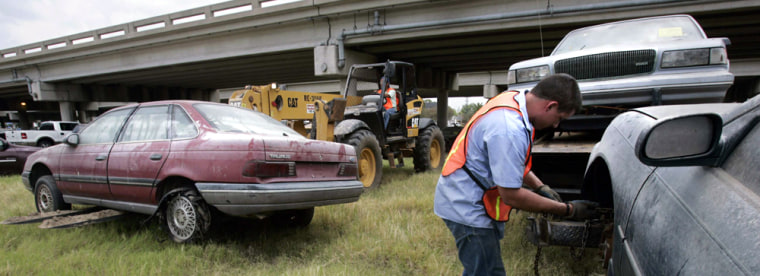NEW ORLEANS — "If you see clothes in a car, then you don't sleep there because it's someone's house," explained Arthur Landry, 58, a native New Orleanean who evacuated to five cities from Tennessee to Texas after Hurricane Katrina hit.
He returned to his hometown in January and has lived in abandoned cars ever since.
Almost one year after Katrina, the storm's most visible reminders are the estimated 50,000 flooded vehicles that litter the city's landscape.They were swept away by the hurricane's winds and 12-foot water currents, or were considered so far beyond repair by their owners that they were abandoned.
What is not visibly apparent is that under the darkness of night, many of these cars serve as overnight shelter for the city's 2,000 homeless people, but not for long. The state of Louisiana has finally started the lengthy process of towing the cars away.
A nightly struggle
In the peripatetic nightly ritual of "catching a car," or finding a place to sleep, some nights there is violence. "I've seen teeth knocked out, broken nose," said Landry, "because not everyone has respect."
"It just goes to show you all the homeless people there are," said James Andrews, 50, who like Landry calls the abandoned car lot in the city's Treme neighborhood home, adding that most nights all of the cars there are occupied by a homeless person seeking an enclosed place to sleep. "The city is still messed up, still messed up."
There are 12,000 people still "houseless" in New Orleans — those who owned homes but lost them to the storm and now live in trailers or with family and friends. Incidentally, there was decrease of 1,000 homeless people in New Orleans after Katrina due to the number of people that relocated or died as a result of the storm, according to Dr. Kevin Stephens, New Orleans Health Department Director. But, that still leaves an estimated 2,000 homeless still searching for shelter on a daily basis.
Describing the effort to find overnight shelter, Landry said, "If there's not a fight in this apartment complex," referring to the Treme car lot, "there's one in the next complex." He points to the cluster of vehicles down the street.
Police patrol
Every night the New Orleans Police Department patrols the cluster of car lots in Treme —evicting would-be tenants of abandoned cars. The Treme area is bordered by Claiborne Avenue, a busy city artery.
“If someone's inside a vehicle and it's not their vehicle, that's considered trespassing," said New Orleans Police Officer Garry Flot. "In my opinion, we haven't had an influx of people calling in to complain."
Landry pointed to a pocket alarm strapped to his belt. It goes off at the same time every day, signaling him to leave before the police come. He returns only after the squad cars leave. “I haven’t been taken away for trespassing, yet,” said Landry.
The masses of abandoned cars speckle New Orleans like the debris piles that fester in the city's Ninth Ward. They are unsightly — and still there. But not for long.
Clean-up coming
With funding from the Federal Emergency Management Agency, the state has contracted DRC Emergency Services to rid the city of its abandoned cars and boats. The company hired a fleet of tow trucks, flatbeds and forklifts and began removing the cars on June 19.
The vehicles will be dismantled for parts — a lucrative procedure given that 25 percent of a new car’s steel is recycled metal — in a process that has yet to be contracted by the state.
State police notify car owners by mail that their cars will be destroyed, giving them 30 days to retrieve their cars by dialing an 800 number, but they don't expect too many calls.
The weathered vehicles are "generally worthless," said Eddie McCarty, project manager with DRC Emergency Services, the state contractor. "There's not a car out there that anyone would want."
In addition to smashed windows and deformed frames, most cars have been stripped of parts, reducing the vehicles, in some cases, to naked shells.
Gone are the tires, hubcaps, leather interiors, radios, mirrors, head rests, and seats, making the clumps of bare metal unrecognizable.
The erratic birthday card, credit card bill, family photograph, or prison inmate release form strewn inside a car can bear clues to tracing the vehicle's previous owner or current part-time occupant.
It's expected to take several months for the state to remove the tens of thousands of abandoned cars.
Closet thing to home
Unfortunately for people like Landry, the unwanted heaps of steel are the closest thing they can call home.
Landry hasn't had painkillers for his arthritis since Katrina. "I don't even have the money to pick up ID, so I can get Medicaid and pay for my medicine," he says, fingering a dog-tag chain around his neck, strung with a cross and three rings he found floating in the water after the storm. "I'm about to cut off my leg, that's how much it hurts."
The Louisiana summer humidity makes his arthritis worse. "I slept in that van last night," he said, pointing, "so I could stretch out for my hip. I can't sleep in a small car like this," he said, waving at a nearby Honda Accord.
Landry slaps at a mosquito on his arm. He holds the bloody bug up on his forefinger.
"All night long. It's what I deal with all night long."
What will he do when the abandoned cars are taken away?
"I need some assistance, some assistance," said Landry, who has been waiting for a FEMA trailer since January. "That's what I need. Give me a trailer, and I'll go from there."
